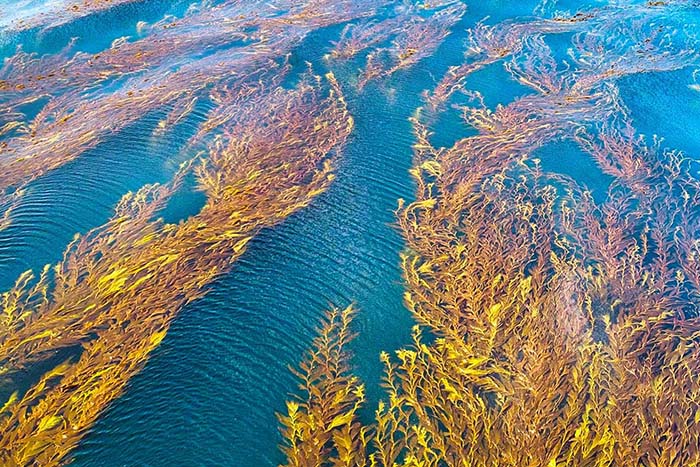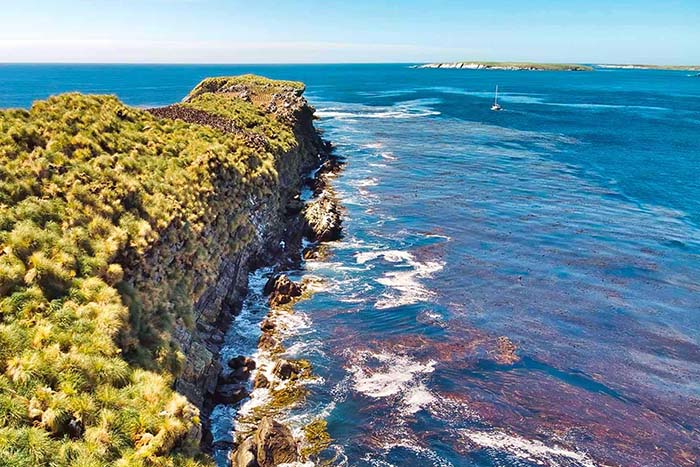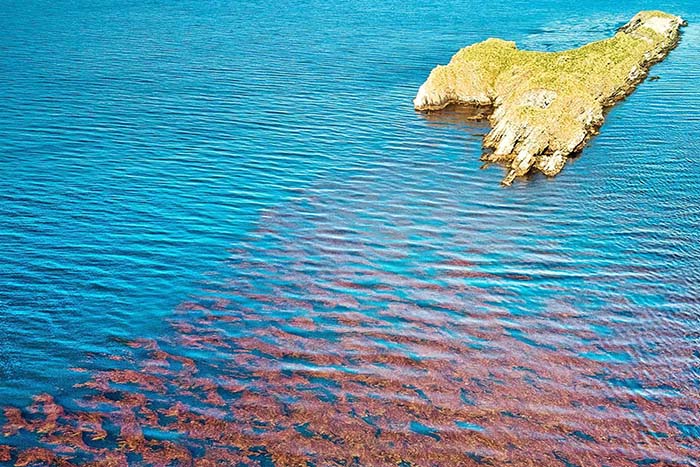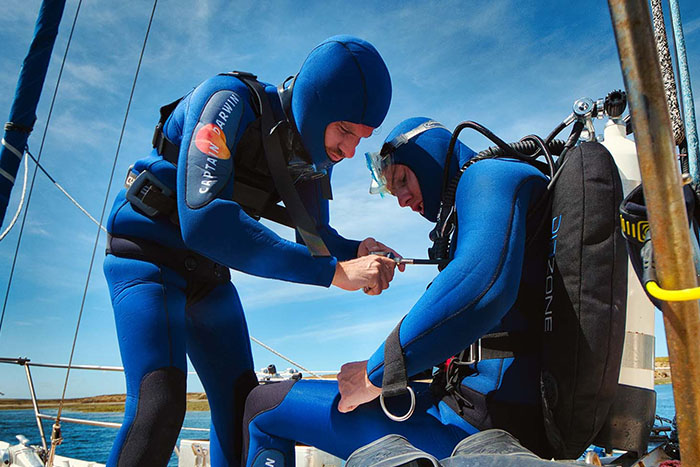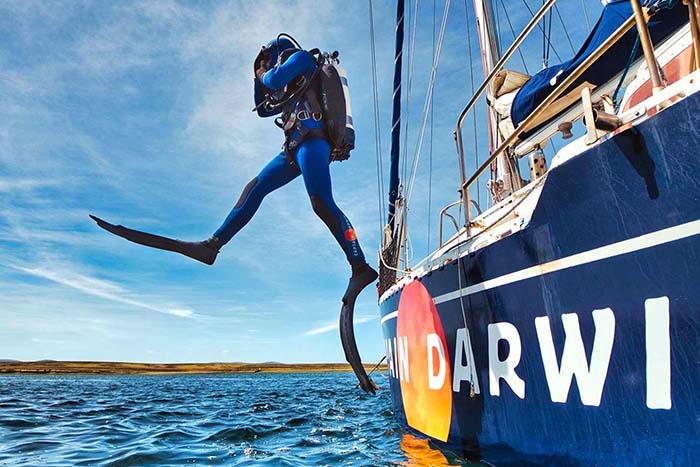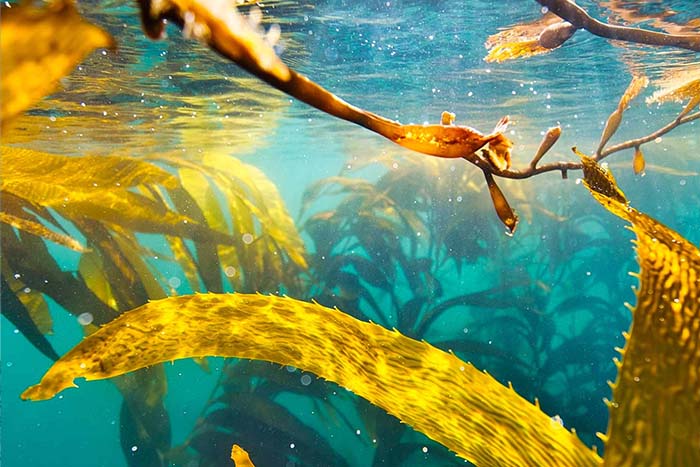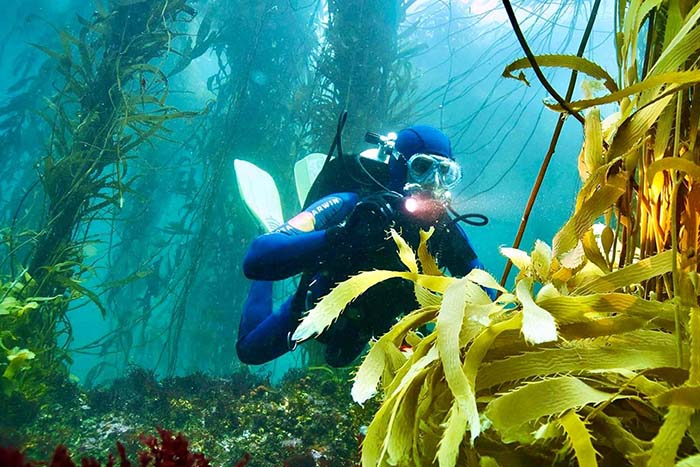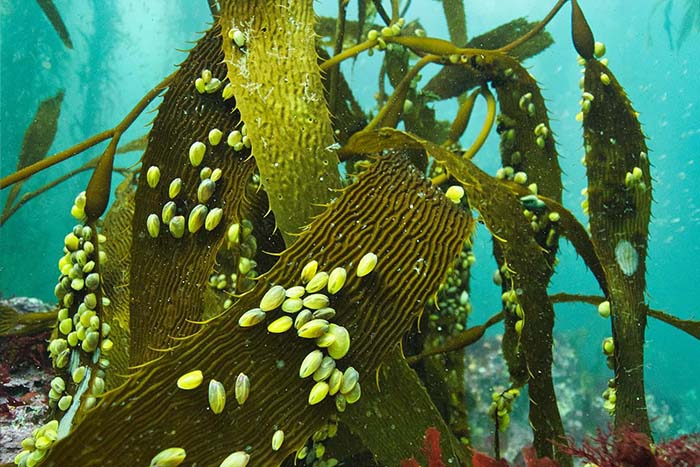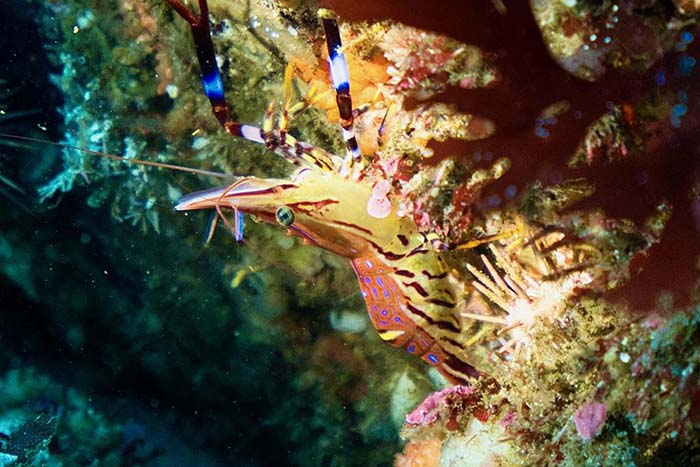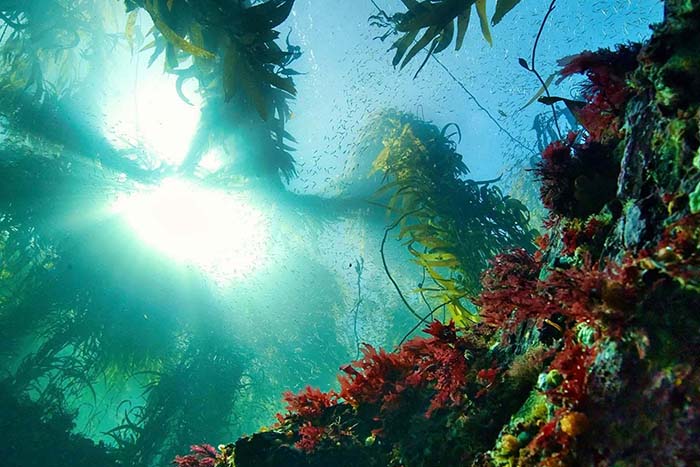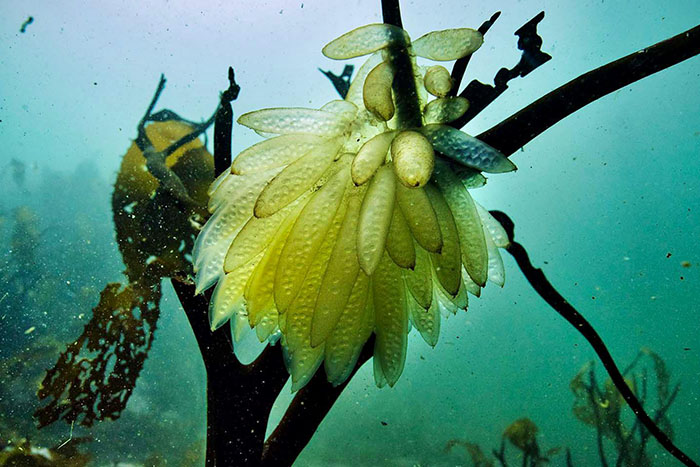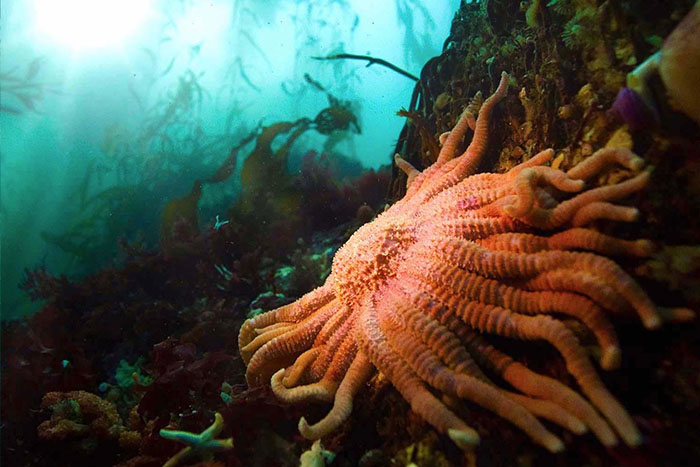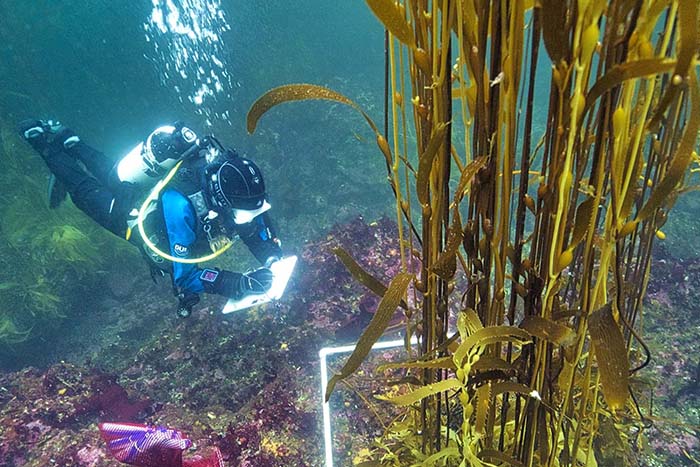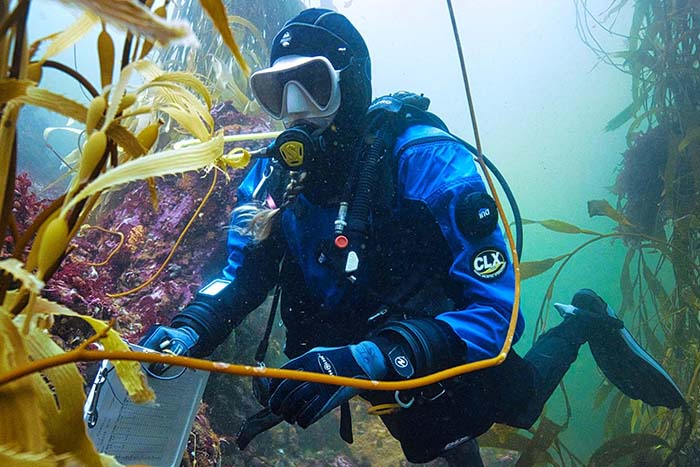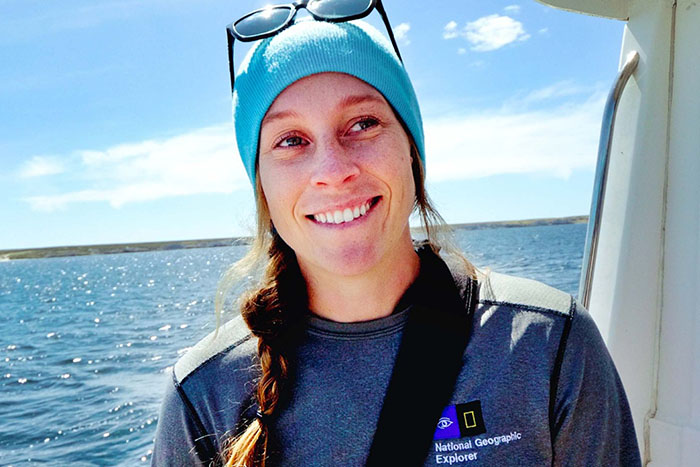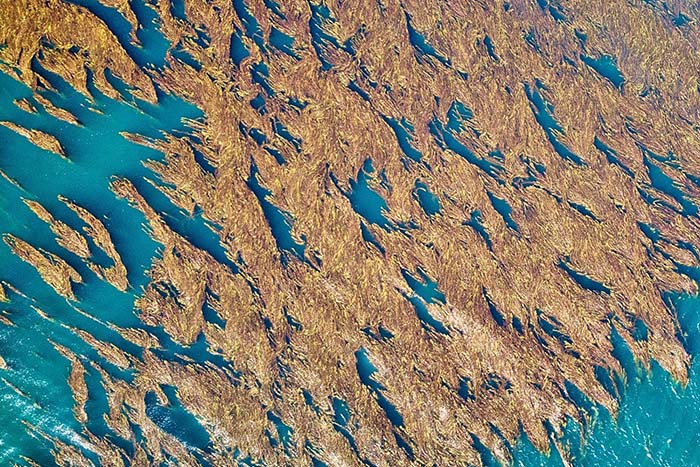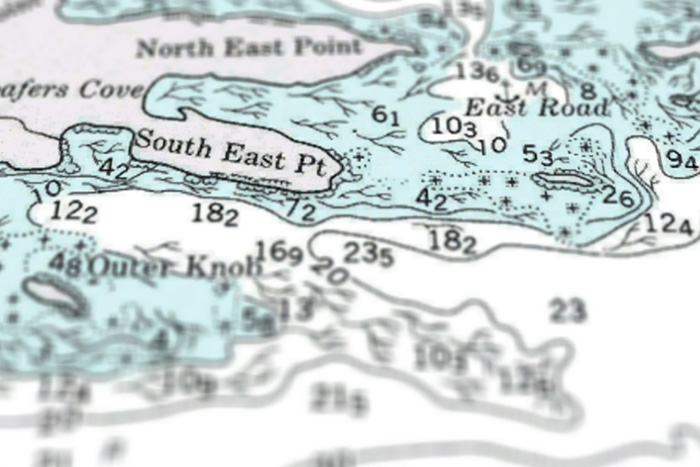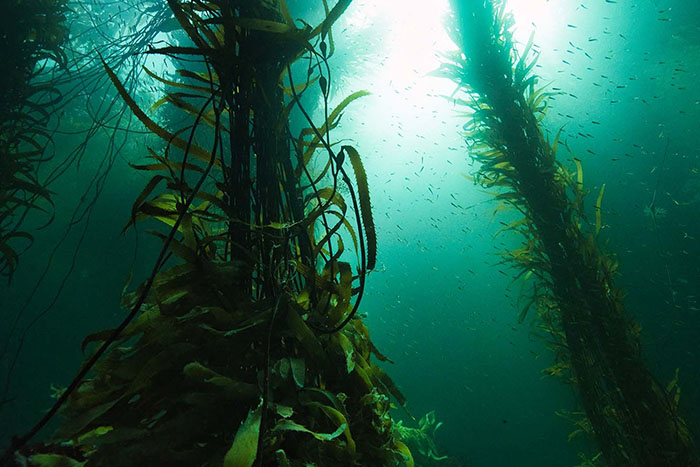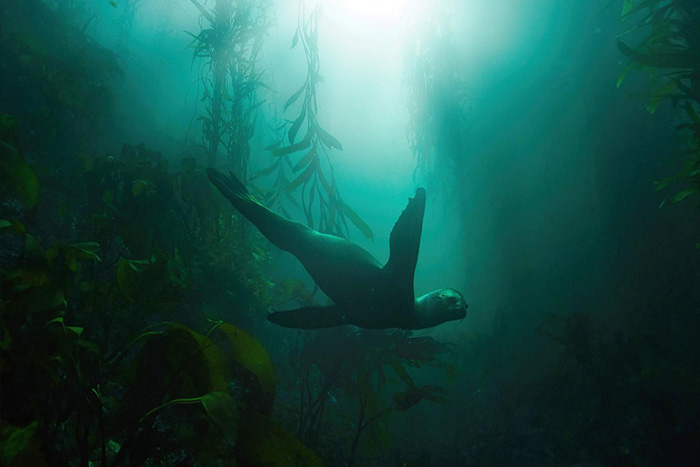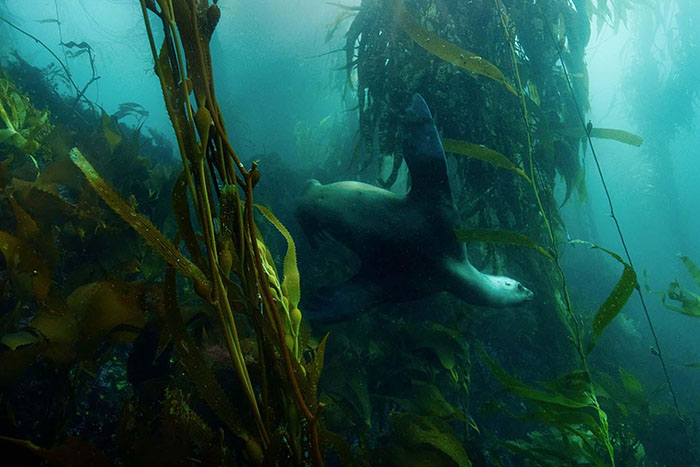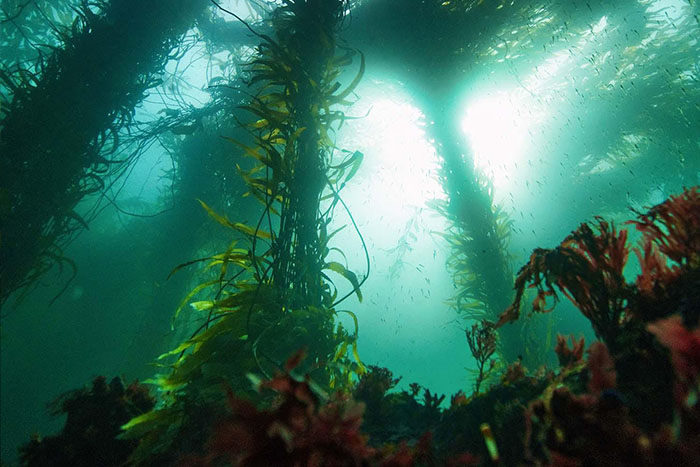Biodiversity Evolution⎢Falkland Islands⎢2023
South Atlantic
Kelp Forests
In partnership with South Atlantic Research Institute
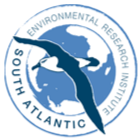
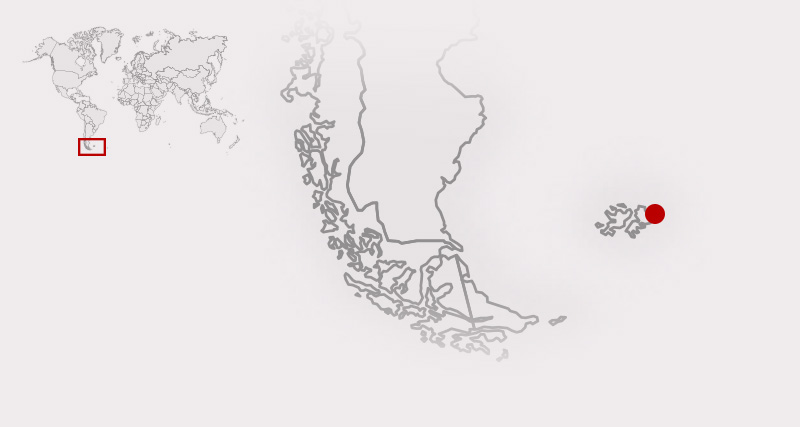
During the HMS Beagle‘s extensive cartographic explorations, Charles Darwin was amazed by the kelp forest ecosystem, a habitat supporting remarkable biodiversity. Along the coasts of the Falklands, Argentine, and Chilean Patagonia, the brown algae Macrocystis pyrifera form magnificent underwater cathedrals, rivaling the ecological significance of terrestrial forests and coral reefs.
In the Falklands, we receive an invitation to join exploration dives with teams from the South Atlantic Research Institute (SAERI) and the Shallow Marine Survey Group (SMSG). Their objective is to deepen modern knowledge of these ecosystems. Alyssa Adler, an American scientist, immerses us in the latest findings about these forests, providing insights two centuries after Darwin’s observations.

1833
There is one marine production, which from its importance is worthy of a particular history. It is the kelp, or Macrocystis pyrifera. This plant grows on every rock from low-water mark to a great depth, both on the outer coast and within the channels.
The number of living creatures of all Orders, whose existence intimately depends on the kelp, is wonderful. A great volume might be written, describing the inhabitants of one of these beds of sea-weed.
I can only compare these great aquatic forests of the southern hemisphere, with the terrestrial ones in the intertropical regions. Yet if in any country a forest was destroyed, I do not believe nearly so many species of animals would perish as would here, from the destruction of the kelp.
– Charles Darwin, Voyage of the Beagle, 1833
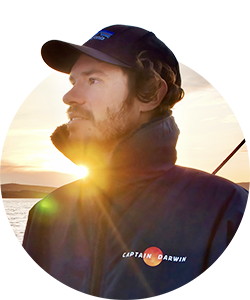
2023
The South Atlantic kelp forests are thriving, largely due to the minimal anthropogenic pressure resulting from the region’s low population density. These ecosystems effectively serve as habitats and carbon sinks.
Comparing old HMS Beagle‘s maps, which depict the extent of kelp forests, with modern satellite imagery, compellingly confirms their maintenance over the centuries.
Kelp forests, present along the coasts of polar and temperate oceans worldwide, face evident decline in certain countries like Tasmania and South Africa, primarily due to local pollution from tourism and fishing.
In the coming decades, climate change is anticipated to exert a significant impact, particularly through the processes of ocean acidification and tropicalization.

1833
There is one marine production, which from its importance is worthy of a particular history. It is the kelp, or Macrocystis pyrifera. This plant grows on every rock from low-water mark to a great depth, both on the outer coast and within the channels.
The number of living creatures of all Orders, whose existence intimately depends on the kelp, is wonderful. A great volume might be written, describing the inhabitants of one of these beds of sea-weed.
I can only compare these great aquatic forests of the southern hemisphere, with the terrestrial ones in the intertropical regions. Yet if in any country a forest was destroyed, I do not believe nearly so many species of animals would perish as would here, from the destruction of the kelp.
– Charles Darwin, Voyage of the Beagle, 1833

2023
The South Atlantic kelp forests are thriving, largely due to the minimal anthropogenic pressure resulting from the region’s low population density. These ecosystems effectively serve as habitats and carbon sinks.
Comparing old HMS Beagle‘s maps, which depict the extent of kelp forests, with modern satellite imagery, compellingly confirms their maintenance over the centuries.
Kelp forests, present along the coasts of polar and temperate oceans worldwide, face evident decline in certain countries like Tasmania and South Africa, primarily due to local pollution from tourism and fishing.
In the coming decades, climate change is anticipated to exert a significant impact, particularly through the processes of ocean acidification and tropicalization.
The kelp forests seen from above
We are in Cochon Island, northeast of the Falklands. On the photo, an island, of course, but also, on the left, at water level, a new field of exploration. As incredible as it may seem, it is one of the many forests of the Falklands. Of course, talking about the forest may seem counter-intuitive, in this territory where the winds blow so continuously that the vegetation cannot, in the vast majority of cases, grow beyond the size of a shrub.
But yet, you have before your eyes photos of a forest… aquatic! You see the seaweed ripples, level with the surface of the water. It is a species called Macrosystis pyrifera, commonly known as “kelp”. Darwin described it extensively in his book “The Voyage of the Beagle”.
“I believe, during the voyages of the Adventure and Beagle, not one rock near the surface was discovered which was not buoyed by this floating weed. The good service it thus affords to vessels navigating near this stormy land is evident; and it certainly has saved many a one from being wrecked.”
This algae is indeed so large that, although its roots can be more than 10 meters deep, it grows until it reaches the surface where it then spreads out for several meters. Spotted hundreds of meters away, this undulating canopy precisely indicates the location of the shoals, allowing us to avoid them.
Naturally, we stay well clear of these aquatic forests, because the strong stems of Macrosystis pyrifera could well wrap around our propeller, stopping the engine dead and leaving us at the mercy of the winds and currents. But these forests fascinate me, as much as they fascinated Darwin and all the sailors who sailed the southern seas. The decision is made: to better understand them, we are going to dive into them!
Getting ready to dive
Get ready to dive in a whole new world! Darwin was fascinated by the kelp forests, but he could only admire them from the surface. He did, however, succeed in describing with much details the astonishing biodiversity that can be found in this ecosystem. He very simply pulled on the straggling stems to observe what’s on them.
But 200 years later, we have an even better exploration tool: diving. It is a very simple one, that we already put to use while exploring Cabo Verde. With an autonomy of 45 minutes down to 30 meters deep, we had a close look at the octopus.
It’s been a year now, so I had to get used to wear the diving gear on my back again… in an 11°C water. We’re still using wet suits, but this time much thicker ones (9 millimeters). I’ve rarely experienced a cloth that hard to put on. And then… it’s the big jump.
While it’s cold in the water, the first glance at the kelp just below water level is so mesmerizing that I quickly forget about it. The stems are elegantly rippling along with the waves, the sun rays are piercing through the surface, and the large trunks of Macrocystis pyrifera dive right to the depths… this wonderful view is giving me the urge to explore what’s further down. See you tomorrow to discover what it looks like at 15 meters deep!
A home for biodiversity
Welcome to the heart of the Falklands forests! The giant kelps soar like trunks, vertically, from the depths to the surface. They then flourish in a canopy that filters the rays of the sun.
It is very difficult to know where to focus your gaze, so much life abounds more than 10 meters deep. Darwin had observed it well during his visit to Patagonia. He writes: “The number of living creatures of all Orders, whose existence intimately depends on the kelp, is wonderful. A great volume might be written, describing the inhabitants of one of these beds of seaweed.”
On the rocky bottom, where the kelps hang their “roots”, there are dozens of species of animals, including Pink Pencil Urchins (Austrocidaris canaliculata), Dog Ear Tunicates (Polyzoa sp. – photo 2), huge Sunstars (Labidiaster radiusus – photo 3), elegant Fringed Nudibranchs (Tritonia sp.) and colorful Painted Shrimps (Campylonotus vagans – photo 4). In these infinitely rich waters, the Patagonian Long Fin Squids come to lay their eggs, which, attached in the form of bags to the roots of the algae, sway with the current (Doruteuthis gahi – photo 5).
As I gradually ascend to the surface, I observe thousands of Kelp Bivalves clinging to certain kelps (Gaimardia trapesina – photo 6). At the bend of another, I meet a small spider crab (Eurypodius longirostris). All around us, countless small fish navigate in schools between the kelps, delighting seabirds, including penguins, who feed on them on the surface.
Kelp forests are thus real residences for hundreds of species: one quickly understands their importance for the biodiversity of the Falklands. We will study in the coming days the evolution of this ecosystem so essential for the marine and terrestrial life of the islands.
Studying kelp forests with Alyssa
Meet Alyssa, an American scientist working on a better understanding of Kelp forests. Alyssa is preparing a thesis at Duke University (in North Carolina), the objective of which is to compare the populations of kelps between the northern hemisphere and the southern hemisphere.
Macrocystis pyrifera, the species of kelp found here in the Falklands, is indeed present on an extremely large latitudinal gradient. They are found from Tierra del Fuego, Chile, to California! Kelp can grow in waters at very different temperatures, unlike animals such as corals, which can survive variations of only a few degrees.
Can we observe morphological variations in the American kelp and the one found in the Falklands? Is the biodiversity that these algae harbor different thousands of kilometers away? Darwin had already noticed a variation in the ecosystem created by Macrocystis pyrifera, between southern and northern Chile. He writes: “In Chiloe, where the kelp does not thrive very well, the numerous shells, corallines, and crustacea are absent; but there yet remain a few of the Flustratceae, and some compound Ascidiae; the latter, however, are of different species from those in Tierra del Fuego; we see here the fucus possessing a wider range than the animals which use it as an abode.”
To study these variations in detail, Alyssa carefully identifies and quantifies the biodiversity found at the foot of the kelps. She also takes samples of algae, which she measures and observes under a microscope once in her laboratory. Some samples will even undergo chemical composition tests to understand in detail the possible adjustments that the species makes according to its habitat.
An exciting work, which allows us to better understand the incredible ecosystem that develops inside the kelp forests.
The evolution of forests since Darwin
How have the kelp forests in the Falklands been doing since Darwin’s time? It turns out that a team of scientists, led by Alejandra Mora-Soto, managed to find the answer to this question in an extremely precise way.
Remember the mission of the HMS Beagle, the ship on which Darwin traveled: to map the southern tip of South America. Some of the maps produced then were so accurate that some of the data collected is still in use today.
These maps contain a set of biological data, and only one: the extension of the kelp forests, signified by numerous intertwined filaments along the coast (photo 2). As Macrocystis pyrifera represents a danger to navigation, as we saw in a previous post, it is quite logical that the presence of this algae is noted on nautical charts.
With this data in hand, Alejandra Mora-Soto had a brilliant idea: to compare the extension of the kelp forests at Darwin’s time with that of today, using the nautical charts produced during the voyage of the Beagle on one side and modern satellite photos on the other.
What is the result of this study? That this ecosystem is about as extensive today as it was 2 centuries ago! Alejandra Mora-Soto and her co-authors write: « Considering the extensive natural and human-caused changes over the last two centuries, this diverse kelp ecosystem is remarkably persistent. In the current context of global change, the need for conservation of this persistent and well-preserved marine ecosystem has never been more important. »
This remarkable preservation noted by scientists is undoubtedly due to a relatively low pressure of human activities in the places where Macrocystis pyrifera develops. The ability of this species to survive significant temperature differences is also at stake. But the game is not yet won: the effects of global warming on this incredible ecosystem could well reverse the trend…
Meeting a sea lion
Unforgettable dive with a sea lion. Incredible… during my last dive in the kelp forests, we were lucky, with Margot who accompanied me for this immersion, to meet a sea lion.
The ecosystem that these algae shelter never ceases to amaze me. It is so rare, nowadays, to immerse oneself in such a wild place where biodiversity flourishes unhindered.
I will therefore end this exploration, before thanking all those who made it possible, with the words of Darwin: “I can only compare these great aquatic forests of the southern hemisphere with the terrestrial ones in the intertropical regions. Yet if in any country a forest was destroyed, I do not believe nearly so many species of animals would perish as would here, from the destruction of the kelp.”
“Amidst the leaves of this plant numerous species of fish live, which nowhere else could find food or shelter; with their destruction the many cormorants and other fishing birds, the otters, seals, and porpoises, would soon perish also.”
A reminder of our responsibility, as humans, to take care of the nature around us, everywhere in the world.



Donate
Help us spread the word about biodiversity by supporting our Patreon!
Social Networks
Follow Captain Darwin on Social Networks to follow our adventures!
Send an email
A question? Something to say? A word of encouragement? Send us an email!
© Captain Darwin 2023 - 1 rue des Senneurs - 29 900 Concarneau - FRANCE

